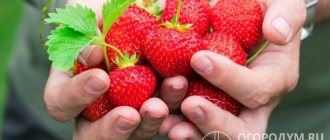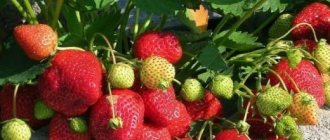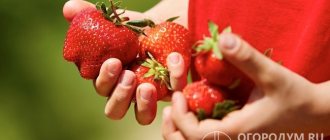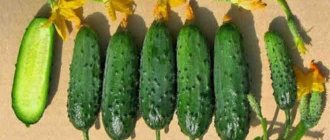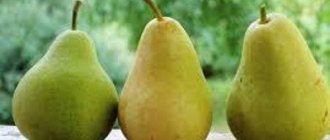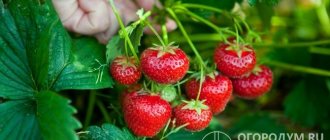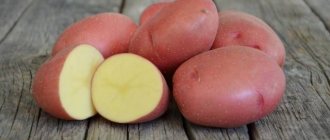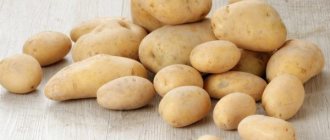Festival strawberries were the most popular variety in summer cottages in Soviet times. This variety is a true gardener's dream; it is highly productive, adapts to any climate, and is completely unpretentious. Let's find out the features of planting and growing this legendary strawberry.
garden strawberry variety "Festival"
The first berries of the Festivalnaya variety are quite large, their weight reaches up to 40 grams
During harvest, the berries of the “Festivalnaya” variety are not damaged, they remain dry and clean
Description of strawberries
Brief botanical description:
- Bushes. Vigorous, well-leafed, compact. The foliage is abundant and erect.
- Leaves. Large, dark green, matte. The surface is wrinkled and ribbed.
- Mustache. Reddish in color. They grow intensively, produce a lot of rosettes - up to 30 pieces per bush.
- Peduncles. There are more than 15 pieces on one bush. Strong and thick, located at the level of the leaves or below, bending under the weight of the berries.
- Inflorescences. Contains several large white flowers. There are 40-50 ovaries on one bush.
- Fruit. The shape is oval, slightly flattened. The surface often has longitudinal grooves on both sides. The color of ripe berries is bright red. The surface is shiny, glossy. Easily detached from the stalks. The pulp is juicy, of moderate density.
The main value of the berries of the Festivalnaya variety is their usefulness. This variety is the leader in vitamin C content. Biochemical composition of the berries:
- sugar – 5.7-11.5%;
- acid – 1.1-1.8%;
- Vitamin C – 73.5-85%.
Advantages and disadvantages of the variety
If we consider the advantages and disadvantages of the variety, the former significantly outweigh.
| pros | Minuses |
|
|
Some characteristics can be attributed to both advantages and disadvantages of the variety.
| Characteristic | Possible disadvantage | Positive aspect |
| Average ripening period | Early products are the most valuable | Allows you to get berries when most varieties have finished fruiting |
| Dense pulp | Not soft enough consistency | Good transportability and keeping quality. The berry retains its shape and does not flow. |
| Lots of mustaches | Creates additional difficulties during care | Easily propagated. If several bushes survive the cold winter, there is no danger of losing the variety. |
| Stretched collection | Additional labor costs | Possibility to get berries longer |
| Pronounced sourness | Sweet berry lovers don't like it | High vitamin C content |
Main characteristics
The variety is non-repairable, the harvest is one, but long-lasting. Fruiting, starting in June, gradually decreasing, lasts until autumn. Table 1 shows the main characteristics of Festivalnaya garden strawberries.
Review of the “Festivalnaya” garden strawberry variety in the video below:
Table 1
| Characteristics | Meaning/Description |
| Ripening time | mid-season variety (first fruits - mid-late June, peak harvest - July) |
| Fruiting | one, long |
| Productivity | 1 kg per bush |
| Berry weight | the largest berries are in the first harvest (their weight is 35-45 g), and then the fruits are smaller to 10-25 g |
| Life cycle | 3-4 years |
| Resistance to diseases and pests | medium (resistant to white spot and gray rot, but often affected by strawberry mite) |
| Drought resistance | low |
| Frost resistance | up to minus 25 °C |
| Taste | sweet and sour |
| Tasting assessment | 4.4-4.5 (out of 5 points) |
| Purpose | universal |
| Transportability | high |
| Safety | high |
a brief description of
Advantages of the variety
It’s not for nothing that the Festival strawberry variety is so loved by gardeners. It has the following advantages:
- Unpretentiousness to the landing site. Can be planted in both shade and sun. This advantage is actively used by gardeners with small plots, planting Festivalnaya between bushes and trees where there is free space.
- Easily propagated by all known methods. It produces enough mustache to renew the plantation every 3-4 years.
- The fruits are large, beautiful, bright. The taste is rated by tasters at 4.7 points. This is an excellent result. Festival wine is at its best and is considered a classic of taste and aroma.
- Productivity is high. Not every large-fruited variety can produce 180 c/ha.
- Long-term fruiting. You can enjoy delicious berries from the middle of the first month of summer until the beginning of September.
- With good shelter it will withstand severe frosts in the Urals and Siberia.
- It is possible to grow on an industrial scale and collect fruits using a mechanized method. Peduncles are compact and do not lie down.
- Strawberries behave well during heat treatment and do not disintegrate into fibers.
The main disadvantage of the Festivalnaya variety is severe damage by root rot. The problem was solved through breeding work, which resulted in the development of the Etafeta variety. Relay is the result of crossing Festivalnaya with several resistant varieties, which took the best qualities from the parent form and practically does not suffer from soil infections.
Disadvantages of the variety
- High demands on watering. If, when planting flower stalks, the plant lacks moisture, the yield will decrease and the berries will be smaller. A temporary drought will ruin two seasons at once.
- Despite the love for timely watering, prolonged waterlogging and lack of sunlight can lead to the development of powdery mildew and late blight.
- Not good for sale. The berries are large but light. Keeping quality is low.
- Severely affected by root rot.
The joys of Festival strawberries are much greater than the troubles. That’s why this “old-timer” is so popular.
Planting Basics
The yield and taste of berries depends not only on the variety, but also on the growing conditions - the composition of the soil, its fertility, and the characteristics of the site. We will learn how to choose and prepare a place for garden strawberries, and how to plant seedlings correctly.
Suitable conditions and soil
The variety grows well on light and loose soils. Unlike most varieties of garden strawberries, Festivalnaya is capable of bearing fruit not only in sunny areas, but also in partial shade - for example, under the spreading crowns of garden trees.
The variety is frost-resistant and grows excellently in temperate climates. Regions in which the Festivalnaya variety can be grown:
- Northern;
- Northwestern;
- Central;
- Central Chernozem;
- North Caucasian;
- Middle Volga;
- Nizhnevolzhsky;
- West Siberian;
- East Siberian.
Selection and preparation of a landing site
Optimal site characteristics:
- The soils are loamy and sandy loam, with a slightly acidic reaction.
- Good sun exposure.
- Protection from winds.
- Low level of groundwater. There should be 2-2.5 m to the water.
- Acidity – neutral.
- The best predecessors are legumes, radishes, beets, carrots, parsley, dill.
- Cannot be planted after tomatoes, potatoes and raspberries. These plants are also bad neighbors.
- After strawberries are grown on the plot, they can be grown again after 6-7 years.
Site preparation:
- After the predecessors, the area is weeded to a depth of 5-6 cm.
- Dig the area to a depth of 25-30 cm. While digging, remove the roots of the weeds.
- Fertilize the area by adding 1 sq. m 5-6 kg of manure or peat, as well as potash fertilizers (20 g) and superphosphate (50 g).
- In the spring, the soil is harrowed with a rake and then weeded as weeds appear.
The timing of planting seedlings depends on the availability of planting material. Gardeners can purchase them from fruit nurseries or grow them themselves.
Garden strawberries can be planted at any time - from spring to late autumn.
Selection of seedlings and their preparation for planting
For planting, only high-quality, sorted seedlings are used. Tips for choosing seedlings:
- seedlings – dense, not flaccid;
- without mechanical damage;
- color – dark green;
- height – 3-5 cm;
- thickness of the central stem – 4-5 mm;
- well-developed root system, root length from 7 cm.
Plant seedlings on a cool, cloudy day. An hour and a half before transplanting, water the seedlings. You can use not just water, but a warm humus solution. The roots of dug up seedlings are soaked for 1.5-2 hours in a growth stimulator, herbal starter or garlic solution. Before planting, it is recommended to dip the roots of the seedlings into a clay mash.
The easiest way to plant seedlings grown using the cassette method. Then each bush is simply transferred with a lump of earth into the prepared hole. This is the method that provides the greatest survival rate.
Planting methods
Garden strawberries are planted:
- Separate bushes. Seedlings are planted at a distance of 55-60 cm from each other.
- Nests. One bush is planted in the center, and 6 bushes around it.
- Carpet method. The bushes are planted in beds, and the tendrils are not cut off. When planted this way, strawberries do not produce large berries.
But the most popular planting method is in rows. Most often, seedlings are planted in 1 or 2 rows, but some gardeners plant 3, 4 or more rows. Methods of planting in rows:
- Single row. The distance between rows is 60 cm. Between neighboring bushes is 20 cm. This method is usually chosen for autumn planting. The first year the seedlings do not bear fruit, but only produce tendrils that fill the space between the rows.
- Double row. This option is more suitable for the spring period. Leave 15 cm between seedlings, 30 cm between rows, 70 cm between rows. If desired, the bushes can be planted more densely - in order to then remove those that do not bloom in the first year or are susceptible to disease.
The recommended planting time for the Festivalnaya variety is early April and early September. This strawberry loves moist soils, and summer planting is not recommended for it.
Planting process
Before planting, it is recommended to cover the beds with an opaque covering material. Sprinkling it with soil around the edges and pressing it with something heavy, holes are made in it for the seedlings. To control weeds and prevent moisture evaporation, you can also use mulch - straw, hay or sawdust.
The procedure for planting strawberry seedlings in open ground:
- Mark the area using twine to dig holes.
- Add a nutrient mixture to the holes - a handful of rotted manure and superphosphate (1 tsp).
- Pour 0.5-1 liters of warm water into the hole.
- Immerse the root system of the seedling in the center of the hole - the roots should be straightened. Sprinkle the roots with soil and compact it with your hands.
- Water again - 0.5-1 liters of water.
Garlic or onions are often planted between garden strawberry beds, and caraway seeds, dill, marigolds, chamomile, and calendula are planted to repel insects.
Origin and description of the variety
In 1926, the Pavlovsk experimental station of the VIR was organized 30 km from Leningrad. The company still operates today, specializing in selection, propagation, and production of elite seeds of vegetable, ornamental, fodder, fruit, and berry crops. In 1954, at this station, as a result of crossing two strawberry varieties, Obilnaya and Premier, Festivalnaya seedlings were obtained. The author is Candidate of Agricultural Sciences Yu. K. Katinskaya. The new variety entered state testing in 1958, and in 1965 it was included in the State Register of Breeding Achievements, as recommended for cultivation in nine Russian regions:
- Severny;
- North-West;
- Central;
- Central Black Earth;
- North Caucasus;
- Srednevolzhsky;
- Nizhnevolzhsky;
- West Siberian;
- East Siberian.
Festival and many other varieties are mistakenly called strawberries. But according to its botanical characteristics, the crop is a large-fruited garden strawberry. It is as a wild strawberry that Festivalnaya is included in the State Register.
Video: how the Festival strawberry sings
Basics of caring for Festival strawberries
The Festivalnaya variety has powerful bushes with many berries and tendrils. The berry requires watering, especially during the formation of flower stalks. Moreover, in the first year of life, the mustache and peduncles must be removed so that the plant develops a strong root system.
When and how to water?
The variety is moisture-loving, so it needs regular moisture. Particular care is taken to observe the watering regime immediately after planting the seedlings. Young plants are watered every two days. Irrigation rate is 9-10 liters of water per 1 sq. m. In the second year, the bushes are watered once a week - 12-15 liters per 1 sq. m. m. The best time for watering is early morning.
Strawberries are watered mainly at the roots. It is especially undesirable for water to get on plants during flowering and fruiting. But before flowering, sprinkling can be used so that the green mass grows better. It is recommended to organize drip irrigation.
Weeding and mulching between rows
Weeding is carried out as weeds appear. They need to be removed on time so as not to waste nutrients and moisture. Simultaneously with weeding, the soil is loosened - mechanically crushed soil loses less moisture and allows more oxygen to pass through to the roots. The depth of weeding and loosening is 2-3 cm.
A simple but extremely effective agricultural technique - mulching the soil - helps reduce moisture evaporation and weed growth. Mulch - peat, straw or other suitable material - is sprinkled on the soil between the rows.
Feeding scheme
They begin to feed strawberry plantings from the second season. Feeding is carried out according to the following scheme:
- When the snow melts and the temperature rises to +2-3 °C, the plants are fed with ammonium nitrate. Fertilizer is simply spread over the area - 30-35 g per 1 square meter. m.
- Half a month after the first feeding, liquid mullein is added. For 13-14 liters of water take 1.5 liters of mullein. The solution is watered between the rows - 3-4 liters per 1 square meter. m.
Read more about spring feeding here.
- Before flowering, the bushes are sprayed with iodine solution (7-8 drops of iodine per 10 liters).
- When the plants fade, add ammophos solution (20 g per bucket). Watering rate – 5-6 liters per 1 sq. m.
- After harvesting, add a solution of chicken manure - 3-4 liters per square meter. m.
Preparing for winter
They begin to prepare for winter immediately after harvesting and until the cold weather. Pre-winter preparation includes the following activities:
- Trimming the above-ground parts of the bushes - remove all leaves.
- Water once a week.
- Fertilizers are applied according to the fertilizing calendar.
- Insulate the beds with peat or straw.
- Place bait for rodents - they can hide in the straw/peat in winter.
Growing and care
In order for the plant to cope with the difficult climatic conditions of most of the territory of Russia, certain agrotechnical practices are required.
Watering
The Festivalnaya strawberry variety needs additional watering if there is a lack of precipitation. Since the peak of fruiting occurs in mid-summer, you need to constantly ensure that the soil does not dry out. Drip watering will help level the situation and deliver the required amount of moisture to each bush. Frequency of watering in dry, hot weather: once every 3-4 days.
Loosening, weed control
Regular loosening of the soil promotes air exchange and prevents the growth of weeds. To effectively combat weeds and heat and moisture retention in the soil, mulching with hay and needles from coniferous trees is practiced (spruce and pine mulch is an excellent prevention of raspberry and strawberry weevil). Covering with black non-woven material, especially on heavy soils and in lowlands, can provoke the development of fungi.
Removing a mustache
Strawberries of the Festivalnaya variety have a lot of whiskers, so it is important to trim them on time. Only those bushes that are planned to be propagated are not touched. If you leave tendrils with rosettes on fruit-bearing plants, the yield will decrease.
Top dressing
Early spring feeding of Festivalnaya strawberries is done with diluted chicken manure (1:20) or cow manure (1:10). The presented fertilizers are nitrogen fertilizers and are necessary for the rapid growth of green mass of bushes. The soil must be pre-moistened to prevent burning of the root system.
Flowering plants are fertilized with potassium nitrate (1 teaspoon per 10 liters of water).
In summer, strawberry beds can be watered once every 10 days with a humate solution. This will extend the period of active fruiting and improve the quality of the fruit.
After the harvest is completed, organic fertilizers are applied in the form of mullein or chicken droppings. During this period, to restore strength, the plant requires ash (1 glass) and urea (1 teaspoon), which must be dissolved in a bucket of water.
Pest and disease control
To prevent diseases and destroy the larvae of wintering pests in early spring, immediately after the snow melts, strawberries are treated with a 3% solution of Bordeaux mixture.
With high humidity, strawberries can be affected by gray rot. If you do not treat the plantations with fungicides in time, you can lose up to 80% of the harvest. A preventive measure can be the installation of film shelters during rainy periods.
Powdery mildew can also develop during prolonged rainfall. To protect the plant from this scourge, the beds are sprayed with a copper-soap solution.
To prevent brown spot, timely removal of old leaves and weeds helps.
Preparing for winter
For the winter, Festival strawberries are covered. All dried leaves, weeds and debris are first removed. Straw, coniferous spruce branches, agrofibre, cardboard and polyethylene are suitable as shelter. In winters with little snow, a covering layer is mandatory.
Diseases and pests
The Festivalnaya variety is affected by various fungal diseases. The prerequisite for damage is increased dampness and shading. Table 2 shows the most common diseases and pests of Festival strawberries, and measures to combat them.
table 2
| Disease/pests | Symptoms/harm | Treatment and prevention |
| Root rot | Black spots appear on young roots. The roots turn black, and behind them the whole bush turns black. |
|
| Black rot | The berries are affected - they turn brown and become watery. |
|
| Root blight | The roots turn orange, the bushes turn yellow and become covered with brown spots. |
|
| Gray rot | A gray fluffy coating appears on the berries. | Similar to the treatment and prevention of late blight |
| White and brown spotting | White/brown spots appear on the leaves. | Similar to the treatment and prevention of late blight |
| Strawberry weevil | Overwinters in the soil, under leaves. They themselves lay eggs in the buds. The ovaries fall off. The larvae, emerging in July, eat the leaves. |
|
| Strawberry leaf beetle | The beetles feed on strawberry leaves. |
|
| May beetle larvae | Roots are damaged. | Spray with insecticides - Zolon, Aktara, Bazudin. |
Correct fit
In order for a crop to retain all its positive qualities, it is necessary not only to properly care for it, but also to plant it correctly. Festival is propagated in several ways:
- Usami.
- Dividing the bush.
- Seeds.
Experts recommend propagating Festivalnaya with mustaches (rosettes). To do this, you need:
- Select the mother bushes. This procedure means choosing bushes in the first year of planting. All mustaches are removed from the bushes.
- These bushes are noticeable.
- Then you need to remove the buds from all the bushes to prevent them from blooming.
Since the plants do not produce berries, they will spend all their energy on the tendrils. These mustaches will give rise to rosettes. Small mustaches are removed, while large ones are left.
There are 2 ways to reproduce with a mustache:
- The first option is to bury the rosette in the ground, water and care for it like an ordinary bush, without separating it from the mother bush.
- The second option is to transplant each rosette into a separate container with soil. This option is considered the most optimal. Then, after the new rosette has completely taken root, it is transplanted to a new place. It is worth noting that 2 weeks before transplantation, you need to separate the whiskers from the mother bush so that the new rosette learns to feed on its own.
Harvesting, storage and transportability
Rules for harvesting and storing crops:
- Berries are collected once every 1-2 days. The fruits should not be overripe - they will be unsuitable for transportation and storage.
- The collection takes place only in dry weather. Berries stored in containers must be completely dry.
- Berries with signs of rot or other diseases are set aside.
- If the berries are intended for storage or transportation, it is better to pick them with the stalk.
- The collected berries are immediately put into containers for storage/transportation - there is no need to transfer the fruits again. Suitable containers are plastic or wooden boxes.
- Store the crop at a temperature of no more than +4 °C.
Landing technology
The preferred site for planting the Festival strawberry variety is a sunny place protected from the wind. It is also desirable that the bed be level and slightly raised, or with a slight slope, so that moisture does not stagnate at the roots.
Note: The crop is undemanding to soil and tolerates partial shade. The ideal soils are loams with a slightly acidic reaction and sandy loam rich in organic matter.
Planting is carried out in the spring, as soon as warm weather sets in, but in the southern regions planting can be carried out at the very beginning of spring. This early movement into the ground is due to the fact that the strawberries must have time to take root before the heat sets in. This is very important, since this variety does not respond well to heat and drought (Figure 4).
Other planting features include:
- The bushes are placed quite far from each other and in a checkerboard pattern. On average, the bush from the bush in the same row should be located at a distance of 60 cm.
- This arrangement of bushes will help avoid replanting plants for five years.
- After a certain period of time, the berry will become smaller and if the daughter rosettes do not take root, then the variety will degenerate.
- If there is not enough time to care for strawberries, then they are planted using the carpet method. Shallow furrows are made at a distance of 50 cm from each other, into which strawberry bushes are placed, maintaining a distance of up to 60 cm.
With the carpet planting method, festival strawberries quickly take over the entire garden bed. In one place with this method of planting, it can grow for up to 3-4 years.
Figure 4. Bush planting technology
The stages of the process of such planting: a handful of mature humus with one tablespoon of superphosphate is added to the hole and all this is mixed with soil, then completely filled with water. Only after the moisture has been absorbed do they begin to plant the strawberries so that the growing point is level with the soil surface. At the same time, water the bed abundantly and then mulch it.
Note: The main thing is not to bury the growing point of the strawberry, as this can lead to the death of the bush. But if planted too high in winter, the bush will crawl out of the ground under the influence of negative temperatures, which will lead to freezing.
Garden strawberries are planted in separate bushes. Seedlings are planted at a distance of 55-60 cm from the bush. Bushes are planted in nests: one in the middle, and around it 6 bushes, using the so-called carpet method.
In the first year, such seedlings do not bear fruit, but only produce tendrils that fill the space between the rows. The beginning of April and the beginning of September are recommended for planting Festival strawberries. Since this variety loves moist soil, summer planting is not recommended for it.
Similar varieties
Today, a modern analogue of the Festivalnaya variety, Festivalnaya Florida, has been bred. This high-yielding variety is distinguished by large berries, very similar to the fruits of the old Soviet variety. An improved analogue was developed at the University of Florida. During the famous Strawberry Festival, the Festival Florida variety received first place based on a comparison of all characteristics.
Festivalnaya is a mid-season variety. They are the most productive. Among the garden strawberries that ripen in the middle are Lord, Harvest, Holiday, Mashenka and many others.
Reviews
I have been growing the Festivalnaya variety for many years. The berries are tender and very sweet. Many varieties, especially remontant ones, are far from “Festivalnaya” in terms of taste. One of the significant disadvantages is the very low shelf life. The morning harvest will begin to flow by evening. One of the reasons is the seeds located on the surface of the fruit, which in the container injure neighboring berries.
The best yield indicators are 700 g per bush; the Festivalny variety shows when grown in central Russia, Siberia, and the Urals. In the southern regions it is too hot for such strawberries, even in the shade.
Reviews about Festivalnaya strawberries
★★★★★
Vera A., Dedovsk. I have been growing this variety for three years now.
I constantly feed the soil with organic matter, but the berries are still not particularly large. The harvest is good, we collect so many berries per hundred square meters that there is enough for all preparations - jams, compotes, fruit drinks, and this year we are going to freeze them in a chest freezer. The variety is not suitable for sale - now there are a lot of strawberries that do not choke or wrinkle during transportation. Festival, rather, for home use. ★★★★★
Leonid T., Lipetsk. We bred Festivalnaya a few years ago - I wanted to evaluate the famous Soviet variety.
Well, the taste is truly wonderful; this variety is suitable for home use. But it's not suitable for sale. During transportation, the berries become wrinkled and release juice. Another plus is long-term fruiting. The first berries appear at the end of June, then they become smaller, but we have berries until the fall. ★★★★★
Reader, Omsk
For 35 years I have tried different varieties of strawberries, I think that the best ones are festival and lord. The first berries, especially in the first year, are very large, then become smaller by the end of the season.
Hide
Add your review
Festival garden strawberries are an old, undeservedly forgotten variety. Its berries will appeal to fans of real strawberry flavor. The variety, giving one harvest, is distinguished by long-term fruiting, extended throughout the summer. The only problem of the variety is instability to the fungus, but modern fungicides help to effectively cope with it.
0
0
Copy link
Characteristics of the strawberry variety Festivalnaya
Medium ripening variety. The first berries ripen from June to July, depending on the region. Fruiting is long, the harvest is harvested in several stages. The bush is tall, powerful, but compact. Clusters of berries are always clearly visible from under the leaves. Peduncles, tendrils, leaf petioles are thick and juicy. The leaves are dark green, with clearly defined teeth along the edges. The berries are scarlet, glossy, often irregular in shape: conical, round, trapezoidal, flattened. The first, largest ones grow up to 35 g, then become smaller. Therefore, the average weight of the fruit is 10 g. The achenes are not pressed into the skin and are located superficially. The pulp is dense, red, juicy. Experts rate the taste as good.
Festivalnaya berries often have an irregular flattened shape, their skin is shiny, and the achenes are not pressed in.
The best strawberry varieties for the southern part of Russia
The southern regions of Russia are characterized by drought and rather scanty precipitation. Therefore, the choice of strawberry varieties for cultivation in areas in the south of the country should be based on resistance to the weather conditions of the region. The following varieties may be your best choice:
Albion
A remontant strawberry variety that can easily be transported. Tolerant to drought, but sensitive to frost and low temperatures.
Albion is planted in closed ground. It is recommended to use organic fertilizers. But watering should be organized so that there is no excess moisture. Strawberries of this variety bear fruit well at +30, but with excess water the berries lose their taste and aroma.
The fruits of "Albion" are medium-sized, bright red and glossy. The flesh is pink, and the smell is almost perfume-like - persistent, slightly intrusive and memorable. "Albion" can be safely called the standard of strawberries.
sergej161:
sergej161
The most fragrant, Albion. Unusual aroma for strawberries. The bed is 40 meters long; when it’s ripe, you can find and pick the berries with your eyes closed.”
Marshal
One of the most unpretentious varieties of strawberries - it easily tolerates drought, is resistant to parasites, and is not picky about the soil. The yield is quite high even in the first year after planting. By the way, this variety was bred in 1890, and is considered one of the oldest cultivated in our time.
The bushes are tall, making a fairly dense planting possible. You can harvest up to 1 kg of strawberries from one bush. The berries are red, quite dense, and easy to transport. The taste of “Marshal” is bright with pronounced sourness.
Lambada
"Lambada" is an early variety of strawberry. It begins to bloom in April, and the first berries appear in early May. The yield is average but stable. It tolerates drought easily, but is susceptible to fungal diseases during the flowering period. Therefore, the bushes need to be processed.
The color of the berries is bright, the sizes are from small to medium. The aroma is pronounced strawberry. Suitable for both fresh consumption and jam.
Reproduction methods
Garden strawberries do not last long, so the fruit crop is propagated and rejuvenated.
- The main way to propagate strawberries is to use shoots or tendrils. The strongest and most developed shoots of an adult bush are selected. At the beginning of summer they are covered with soil, and at the end of the season they are cut off along with the roots that have formed and planted in separate beds.
- Dividing the bush helps to rejuvenate the old plant and grow new berry bushes. An adult bush is dug up, cleared of soil and carefully divided into equal parts. Each seedling should have developed rhizomes and several green leaves. New bushes are planted in separate beds.
- Seed propagation of strawberries takes a lot of time and patience, but the result is healthy, fruit-bearing plants.
Variety selection
Work on developing a new variety of fruit crop began in the 50s of the last century. Soviet breeders set themselves the task of developing a completely new, frost-resistant and productive variety of strawberries. In 1958, a new variety of fruit crop was submitted for the state procedure to determine varietal characteristics.
The new strawberry received its name in honor of the Festival of Youth and Students, which took place in Russia in 1957. As a result, tests have shown that Festivalnaya strawberries can be grown on any soil in different climatic zones.

